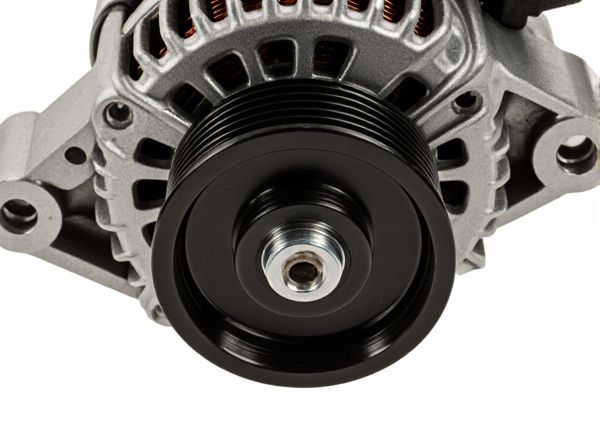
Photo illustration: Serpentine Pulley vs V-Belt Pulley
Serpentine pulleys use a single continuous belt to drive multiple accessories simultaneously, offering smoother operation and easier maintenance compared to V-belt pulleys, which rely on multiple belts for each accessory. Your engine's efficiency and reliability can improve with serpentine pulleys due to reduced belt slippage and better alignment. Choosing between the two depends on your vehicle's design and the specific performance requirements.
Table of Comparison
| Feature | Serpentine Pulley | V-Belt Pulley |
|---|---|---|
| Design | Single, continuous flat belt | Multiple separate V-shaped belts |
| Efficiency | Higher efficiency, less slippage | Lower efficiency, more slippage |
| Maintenance | Low maintenance, easier replacement | Higher maintenance, frequent adjustments needed |
| Durability | Longer lifespan under normal conditions | Shorter lifespan, prone to wear and tear |
| Noise Levels | Quieter operation | Louder due to belt friction |
| Application | Modern vehicles, single belt style | Older models, multiple belt configurations |
Introduction to Serpentine Pulley and V-Belt Pulley
Serpentine pulleys are designed to work with serpentine belts, which are flat and wider, allowing them to drive multiple accessories simultaneously with better grip and less slippage. V-belt pulleys, in contrast, use a V-shaped belt that fits into the pulley groove, providing strong friction and efficient power transmission primarily for single applications. Understanding the differences in belt design and pulley groove shape is essential for selecting the optimal system for specific automotive or mechanical needs.
Basic Design Differences
Serpentine pulleys feature a single, continuous groove that accommodates a multi-ribbed belt, allowing for more surface contact and better power transmission. V-belt pulleys have multiple V-shaped grooves designed for individual V-belts, providing high friction but less belt flexibility. The serpentine design enables compact routing and reduced belt slippage, while V-belt pulleys require precise alignment to maintain tension and efficiency.
Mechanism of Power Transmission
Serpentine pulleys use a single, continuous multi-ribbed belt to transfer power smoothly across multiple components, reducing slippage and improving efficiency. V-belt pulleys rely on a wedging action between the V-shaped belt and the pulley groove, creating high friction for power transmission but often requiring more maintenance due to belt wear. The serpentine system's design allows for compact layouts and consistent tension, enhancing overall power delivery compared to traditional V-belt drives.
Material and Construction
Serpentine pulleys are typically made from durable materials like aluminum or steel with smooth, flat surfaces designed for multi-ribbed belts, enhancing grip and reducing slippage. In contrast, V-belt pulleys are usually constructed from cast iron or steel with V-shaped grooves tailored to fit individual V-belts, providing concentrated friction and power transmission. The construction differences reflect their distinct belt compatibility, with serpentine pulleys favoring flexibility and efficiency, while V-belt pulleys emphasize strength and targeted grip.
Efficiency and Performance
Serpentine pulleys enhance efficiency by using a single continuous belt that reduces slippage and distributes tension evenly, leading to improved power transmission and lower maintenance requirements compared to V-belt pulleys. V-belt pulleys, while effective in individual drive applications, often suffer from higher friction losses and require more frequent adjustments to maintain optimal performance. Overall, serpentine pulley systems deliver superior durability and consistent performance in high-demand automotive and industrial applications.
Installation and Maintenance Requirements
Serpentine pulleys require precise alignment and tensioning due to their single, continuous belt design, which simplifies installation but demands regular inspection to prevent slippage and wear. V-belt pulleys involve multiple belts that need individual tension adjustments, increasing installation time and maintenance complexity to ensure optimal performance and prevent uneven wear. Both systems benefit from routine maintenance, but serpentine systems often reduce downtime with less frequent belt replacements compared to V-belt setups.
Cost Comparison
Serpentine pulley systems generally have a higher initial cost due to their complex design and the need for specialized belts, compared to the simpler and more affordable V-belt pulley systems. Maintenance expenses for serpentine pulleys tend to be lower over time because of their increased durability and reduced belt replacement frequency. V-belt pulley systems may incur higher long-term costs due to frequent belt wear and the need for regular adjustments, making serpentine pulleys more cost-effective in the long run.
Lifespan and Durability
Serpentine pulleys generally offer enhanced durability due to their design, which distributes tension evenly across a single belt, reducing wear and tear compared to V-belt pulleys that use multiple belts prone to uneven stress. The lifespan of serpentine belts and pulleys typically exceeds that of V-belt systems, lasting up to 60,000 to 100,000 miles under optimal conditions. Maintenance is often simpler with serpentine pulley systems, as they require less frequent adjustments and replacements, contributing to overall longer service life.
Common Applications and Uses
Serpentine pulleys are widely used in automotive engines to drive multiple accessories such as the alternator, power steering pump, and air conditioning compressor with a single continuous belt, ensuring compact and efficient power transmission. V-belt pulleys commonly find application in industrial machinery, HVAC systems, and agricultural equipment where separate belts drive individual components, allowing for easy maintenance and belt replacement. Both pulley types are essential in mechanical systems, with serpentine pulleys favoring space-saving and consistent tension, while V-belt pulleys excel in heavy-duty and variable torque applications.
Choosing the Right Pulley System
Selecting the right pulley system between a serpentine pulley and a V-belt pulley depends on application efficiency, load requirements, and maintenance needs. Serpentine pulleys offer enhanced grip and reduced slippage through multi-ribbed belts, making them ideal for high-performance automotive engines, while V-belt pulleys provide simplicity and cost-effectiveness for lower power transmissions. Evaluating factors such as belt tension, durability, and operational smoothness ensures optimal performance and longevity in mechanical systems.
 caratoz.com
caratoz.com